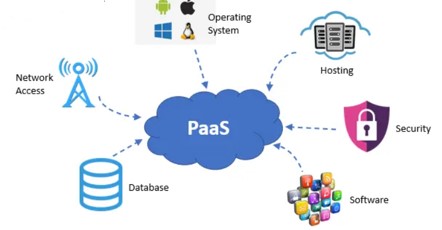Cloud Computing - Platform as a Service(PaaS)
In this tutorials, we will look at one of the most essential services of Cloud Computing known as Platform-as-a-Service. Platform as a Service (PaaS) is a cloud computing service model that allows developers to build, deploy and manage applications without worrying about the underlying infrastructure. You can purchase these applications from a cloud service provider on a pay-as-per use basis and access them using the Internet connection.
Example - Google App Engine, Force.com, Joyent, Azure
In PaaS, the developers usually rent the requirements from the cloud vendors to build an application.

Real World Example
PaaS is similar to a renting a fully-equipped kitchen to cook your favorite meals without worrying about owning or maintaining the kitchen appliances. Now we can understand it in a simple way, Imagine that you love cooking, but you don't have your own kitchen. So you need a kitchen for cooking. You go to a restaurant and take a kitchen on rent that already has all the pots, pans, and ovens you need to prepare recipes. This way, you can focus on cooking your recipes without worrying of setting up or cleaning the kitchen.
We will explain it in the world of technology.
- PaaS provides you with tools and services - Just like the rented kitchen offers cooking tools like pots, pans, and ovens, PaaS gives you software tools and resources to build and run your computer applications. These tools include databases, programming languages, and development environments.
- No need to worry about infrastructure - When you rent a kitchen, you don't need to buy or maintain any appliances. They come with the rental. Similarly, with PaaS, you don't have to worry about the servers, storage, or networking. The cloud provider takes care of all that for you.
- Focus on your recipes (code) - You can concentrate on creating your apps or software (your recipes) and not get bogged down by the technical details of managing servers or hardware.
- Scalability - Just as you can rent a bigger kitchen for a large dinner party, PaaS allows you to easily scale up your computing resources when you have more users or need more power for your applications.
- Cost-efficiency - PaaS often follows a pay as you use model, similar to renting a kitchen by the hour. You pay for the resources you use, which can be more cost-effective than buying and maintaining your own infrastructure.
- Collaboration - Multiple chefs (developers) can work in the same kitchen (PaaS platform) on different dishes (applications) at the same time. It increase teamwork and efficiency.
Advantages of PaaS
- Reduce Coding Time - In Platform-as-a-Service(PaaS), The development softwares in PaaS will help the developers to write code and also develop new applications. There are some already added components to build an application.
- Single Environment - PaaS provides you a single environment where developers can build, test, debug, run, host and update applications. There is no need to do anything extra.
- Licensing Ease - PaaS providers will manage the licenses of operating systems, development tools, and everything available on their platform.
- Support Geographically Distributed Development - As the development environment is accessed and managed over the internet. If the development team can combine together on some critical projects, even if the team members are not located in same locations worldwide.
- Development in Multiple Platforms - Some service providers like AWS, Azure, and GCP will provide you development options for multiple platforms as you like such as computers, mobiles, and browsers, which quickly develop cross-platform applications.
- Pricing - PaaS is less expensive than leveraging IaaS in many cases. Overhead is reduced because PaaS customers do not have the stress to manage virtual machines. Additionally, some providers have a pay-as-you-go pricing structure, during which the seller only charges for the computing resources employed by the appliance, usually saving customers money.
-
Instant community - PaaS vendors frequently provide online communities where the developer can get the ideas to share experiences and seek advice from others.
Disadvantages of PaaS
The following are some of the disadvantages when you use PaaS cloud services.
- Limited Control - PaaS abstracts a large portion of the underlying infrastructure, you have less control over the hardware and software stack. This can be a drawback if fine-grained control is required for certain configurations or optimizations.
- Vendor Lock-In - When you write code for your applications on a PaaS platform, you may become dependent on the providers tools like APIs, and services. Migrating away from the platform is not so easy as can be challenging and costly leading to vendor lock-in.
- Limited Customization - PaaS platforms often have pre-configured environments. While this makes development easy, it may limit your ability to customize things at runtime environment to your exact needs.
- Cost - While PaaS can offer cost savings compared to using your own infrastructure, You pay for resource you use. if you do not use your resources carefully. You will spend more money.
- Data Privacy - Corporate data, whether it can be critical or not, will be private, so if it is not located within the walls of the company, there can be a risk in terms of privacy of data.
Next
